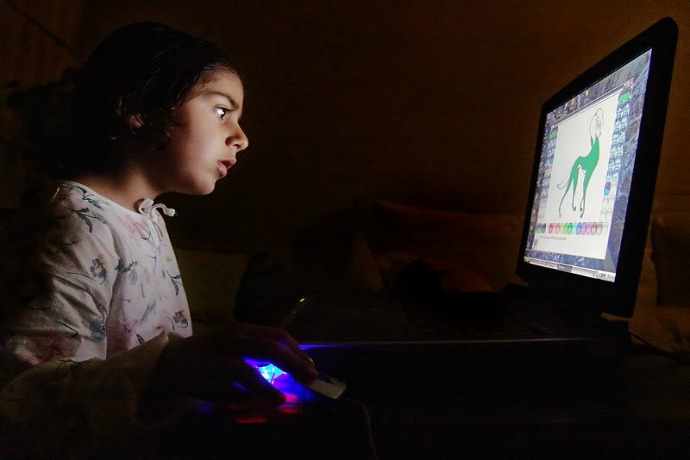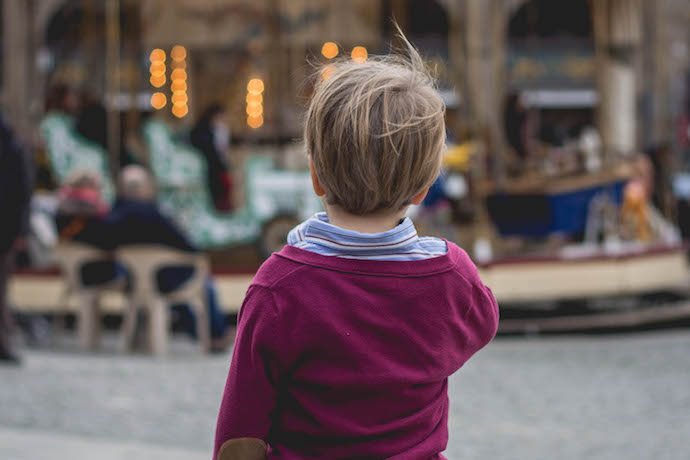In an increasingly connected world, we parents can feel overwhelmed about making sure our kids are protected and knowing how to talk to kids about safety, strangers, and all that other stuff that we wish we didn’t have to. We know it can be tough. While keeping our kids safe is a huge priority for all parents, we also want them to experience the beautiful freedom of childhood, and the ability to run and play and make friends without fear.
So how do we all balance those two? We’re here to help.
Related: Letting your kids play outside alone or walk to school:
Is it bad for kids, or just bad for parents?
First, we should be clear that we tend to have an optimistic outlook of the world as it relates to our kids. Our regular readers will notice that we aren’t particularly alarmist, and that we don’t suggest that letting your responsible tweens play in the park alone or even letting them wear t-shirts with their name on it will lead to imminent danger.
Fortunately, research bears this out; while most people seem to believe the world is more dangerous now than ever before (thanks, 24/7 cable news networks!), you can be reassured that statistics prove kids are actually safer today than ever. As you’ll see below, the biggest danger to a child is getting lost, not being abducted by a stranger.
The other thing that’s changed since we were kids is exactly how we talk about staying safe.
So here are some tips we’ve found really helpful in teaching our own kids about strangers and safety, and how to be smart when they’re in public places either with you or alone. We really hope you find them helpful too.
1. Start talking to your kids about safety early
Our littlest kids are the most defenseless, so it’s important to start conversations about safety and boundaries when they’re as young as two or three years old — in an age-appropriate way, of course.
Tell them why it’s always important to ask their parent or caregiver for permission before they go off with anyone else. Tell them they are the boss of their own body, and no one is allowed to touch them in any way at all that they don’t like. And assure them that they can always come to you anytime someone makes them feel uncomfortable or scared and that you will never be mad at them.
This is one of the reasons kids are most likely to withhold information, so it’s really important to keep the lines of communication wide open.
2. Talk about “tricky people” instead of strangers.
While “stranger danger” was the phrase a lot of us grew up with, now, we realize it’s better to teach the concept of “tricky people.”
We’re not sure where the term first started — some credit Jan Wagner and others credit Pattie Fitzgerald, both child safety experts. We just think that whomever coined it was brilliant, because dangerous adults may not be strangers to a child at all (ugh, we know), and most often, strangers can actually be kind helpers.
So teach your kids to look out for “tricky people,” or adults who ask them to break their safety rules, violate privacy, keep secrets from their parents, or just give them an “uh-oh” feeling in any way.
One of the clearest warning signs of a “tricky person” that any kid should be able to recognize is an adult who asks a child for help — like finding a puppy, or moving something for them. Tell your kids in no uncertain terms that an adult never needs a child’s help. Adults ask other adults for help, not young kids they don’t know.
3. Tell your kids it’s okay to be rude
This is a hard one for a lot of us; I was painfully polite as a child, even when it might have done me some good to stand up for myself and say no on certain occasions. But ah, peer pressure is strong. Encourage your children that it’s okay for them to say no, even forcefully, if they get a feeling that they’re in any kind of unsafe situation.
If an adult gets pushy about doing something your child knows isn’t safe or right, let them know it’s important to say no, even if that adult is someone they know, like a coach or a friend’s older sibling or someone in a uniform. That’s a tough one for kids, who generally learn to respect adults and authority.
You can also tell them that if they need help, they should do whatever it takes to draw attention to themselves to get help, even screaming, yelling, kicking, and fighting back.
But it’s also good to teach kids to say no to even people who “look nice” and to other friends. If another child encourages them to ride their bike farther from home than they’re allowed, to go into an area that’s closed or barricaded, or to play a game that feels like it violates their boundaries of privacy, they should firmly decline.
Related: Temporary safety tattoos: A life saver for kids who like to wander.
4. Role play, and be specific
The best way to be prepared for any event in life is to practice for it, so spend some time with your kids practicing what they’d do if they encountered a “tricky person.” While you don’t need to go into horrific details of worst case scenarios, kids do need to understand that some adults intend actual harm to children — whether in real life or online. If they don’t recognize the danger, they won’t take it as seriously, and specific examples help them understand which behaviors should not be trusted.
Just be sure to speak to a child’s age and maturity level, and give examples of some of the things a “tricky person” might say, like, “Could you come help me find the ice cream store?” Then, again, teach them the response is a forceful, NO!
Of course, you can keep it lighthearted and silly with the youngest kids. Be the bad guy in a Disney villain-like way so your kids still get to practice the right way to respond and react to a potential threat. Or just say, “can you help me find my kitten that I lost somewhere around here?”
When you role play, you can also suggest that when your child calls for you, that they call you by name. “Mommy” may be tougher for you to distinguish in a park full of kids, than a child yelling “KATE ETUE!”
Giving kids specific responses and reactions to use will be incredibly helpful should the need ever arise.
5. Stay focused on a child’s most likely problem: Getting lost.

It’s important to remember that most common danger for a young child is not kidnapping or other situations too awful to think about — it’s that they’ll wander off from their parents and accidentally get lost.
One of my favorite safety books for kids is the sweet story book When Lyla Got Lost (and Found) by Abbie Schiller and Samantha Kurtzman-Counter. In it, 6-year-old Lyla tells, from her perspective, what it felt like to get lost and shares tips for what to do if you get lost too.
Her advice to look for a mom with kids, or talk to someone working a cash register in a store, are easy things that even a young child can remember. And while there’s a lot of debate about the advice to tell children to “look for a mom” — as a lot of our wonderful partners, husbands and dad friends will tell you — we still think it’s a good choice.
6. Talk about online safety and risks

In all likelihood, the biggest threat our kids will ever face is online safety. As you start to give your kids access to their own devices, it’s essential that you share the importance of protecting themselves online.
The biggies are: never share your personal information (your address, age, school, sex or real name); keep your passwords private; don’t develop relationships with people online who you don’t know in real life. Make it clear to your kids just how easy it is for an adult to create a fake account and pretend to be someone they aren’t — they shouldn’t assume that someone named @purplespark1yunicorn13 who claims to be a 12-year-old girl is exactly who they say they are. Even (and especially) if their avatar is that of a child.
You may know the basics. But as Liz found out when her daughter got her first email account, there are so many online safety and privacy issues that you may never have even considered discussing.
For example, it’s good to talk about leaving digital footprint — the legacy we are all creating through every piece of information we share online. As kids get older, that conversation will get tougher and more specific. But it should really start young.
We know that parenting kids online, especially for those of us who didn’t have the Internet as kids ourselves, is a whole new ballgame. But we’ve got your back! You can find tons of advice at Cool Mom Tech, and here are a few favorite posts that we think are really valuable:
–Easy, expert internet safety tips for parents that you can start using right now
–How to talk to teens and tweens about smart tech use and safety
–11 essential tips for parents before setting up a kid’s first email account
–How to know if your child is ready for a cell phone: 5 honest questions to ask yourself
–12 features and considerations before you buy your kid’s first cell phone
–4 apps kids are using that parents should really know about
–99 texting acronyms and phrases every parent should know
–The best kids tablets in terms of security, function and parental controls
7. Be clear about your expectations
Finally, make your expectations clear, so your kids know exactly what you want from them. It’s incredibly important to phrase it like: “I expect you to never go with anyone without getting permission from me first…” or, “I expect you to say no when your friends ask you to do something I’ve told you is unsafe.”
Then, once ground rules are set, say something like, “I expect you to use your devices within the guidelines we’ve set for you.”
Cover the loopholes too: “Yes, even if x, y, or z.” This will help you talk through strategies of what to do in unexpected situations — like you’re delayed picking them up from school. Or a friend suggests that “Mom/Dad said it was okay” to do something, even though the child never asked.
It might feel like a lot to discuss, and you might get a few eye-rolls in the process — especially with your older kids — but as the old adage goes, better safe than sorry. And we definitely vote for safe.
top photo via Marjorie Bertrand at Unsplash






These are very wonderful and helpful tips. i like the tricky adult part because sometime our kids tend to be hurt by people they know so making them understand that everyone is a potential dangerous person is important. In as much as we can’t tell them outright to stay away from people they know, outlining the danger signs is crucial so as soon as they see it from whoever they will know.
thanks for sharing
Really wonderful piece, Kate! We are putting it into action immediately!!